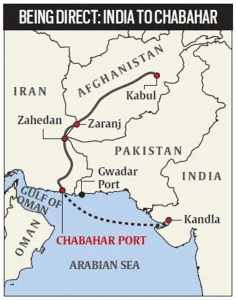TAG: GS 2: INTERNATIONAL RELATIONS
THE CONTEXT: The Chabahar port, situated at the mouth of the Gulf of Oman, holds paramount strategic importance for both Iran and India. The recent discussions between Indian External Affairs Minister and Iranian Minister underscore the ongoing efforts to establish a long-term cooperation framework for this key maritime asset.
EXPLANATION:
Historical Context and Strategic Significance:
- India’s involvement in the Chabahar port dates back to 2002 when discussions initiated between the then National Security Advisor to Iranian President, and his Indian counterpart.
- As India sought alternative trade routes due to severed land connections with Iran and Central Asia post-Partition, Chabahar emerged as a crucial element in its geopolitical strategy.
- Chabahar not only provides Iran with a deepwater port on the global oceanic trade route map but also offers India an alternative route.
- It bypasses Pakistan’s restrictions on land access for trade with Afghanistan and Central Asia.
- Furthermore, the port is integral to the proposed International North-South Transport Corridor (INSTC).
- It connects the Indian Ocean and Persian Gulf to the Caspian Sea and northern Europe.

India’s Involvement and Development Progress:
- India’s engagement in Chabahar began gaining momentum in 2016 when a trilateral agreement was signed between India, Iran, and Afghanistan.
- The first phase of the Shahid Beheshti port was inaugurated in December 2017, marking a significant milestone.
- However, the overall development of the port has faced delays, a common challenge for ambitious infrastructure projects in India’s neighboring regions.
Geopolitical Roadblocks:
- The primary reason for the slow progress in Chabahar’s development lies in geopolitical challenges, particularly Iran’s complex relationship with the United States.
- The US-Iran dynamics, marked by sanctions and international pressures, have significantly impacted the pace of the project.
- Despite a temporary “carve-out” for India in Chabahar under the sanctions regime, finding international suppliers for necessary materials remained challenging.
Future Prospects:
- Recent geopolitical developments, including the US exit from Afghanistan and the return of the Taliban, have influenced India’s ties with the region.
- The reopening of India’s embassy in Kabul and financial allocations for the Chabahar port project signal renewed commitment.
- However, the project’s future progression depends on the evolving US-Iran relations, which may further complicate or expedite the development based on future geopolitical
Conclusion:
- Chabahar port stands as a symbol of India’s quest for diversified trade routes and geopolitical influence in the region.
- While challenges persist, proactive diplomacy, efficient implementation, and sustained cooperation between Iran and India could ensure the viability and success of the Chabahar project as a pivotal transit hub and link in the larger geopolitical landscape.

